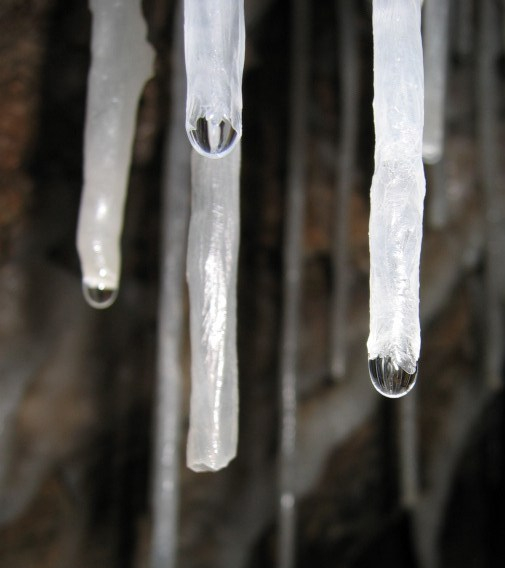Nella Grotta del Vento sono molto frequenti delle stalattiti sottilissime, quasi filiformi, generalmente traslucide e vuote all’interno. Talvolta la calcite che le compone è talmente pura da farle apparire trasparenti come il vetro. Comunemente vengono indicate come “spaghetti”, anche se sarebbe più logico definirle “bucatini”, visto che all’interno sono cave. Sono anche dette “capelli d’angelo”, ma il nome più accettato dal mondo scientifico è il più prosaico “cannule”.
Queste singolari concrezioni, spesso molto vicine tra loro e molto sviluppate in lunghezza, costituiscono la forma più elementare, oltre che la fase iniziale della maggior parte delle stalattiti.
Hanno sempre origine nel punto in cui le leptoclasi, sottilissime fenditure della roccia entro le quali l’acqua scorre, generalmente in condizioni di capillarità, sboccano sul soffitto di una cavità sotterranea.
Quando una goccia satura di bicarbonato di calcio si ingrossa prima di staccarsi, con l’aumento della superficie si verifica una fuga di anidride carbonica che trasforma il bicarbonato disciolto in carbonato di calcio, solido e cristallino. Attorno al foro d’uscita dell’acqua si forma un anellino di microscopici cristalli di calcite che tendono ad accrescersi verso il basso via via che si staccano altre gocce. Tra i vari cristalli ha inizio una competizione selettiva in seguito alla quale uno solo prevale, formando un corpo cavo che continua a crescere finché continua l’alimentazione. Si viene così a formare una stalattite monocristallina cava, le cui pareti sottilissime hanno uno spessore quasi sempre inferiore a mm. 0,5. La cavità interna, che viene percorsa dall’acqua, è detta “meato di alimentazione”
Il diametro delle cannule corrisponde a quello che una goccia assume al momento del distacco. Sul pianeta Terra è di mm. 5,1. Se su Marte esistessero l’acqua e le grotte, a causa della minore forza di gravità, per vincere la tensione superficiale dell’acqua la goccia dovrebbe essere più grossa, con un diametro di mm. 8,3. Sulla Luna il diametro sarebbe addirittura di circa 13 millimetri.
Le cannule possono ingrossarsi, formando le normali stalattiti cilindro-coniche che possiamo vedere in quasi tutte le grotte. Ingrossandosi possono fondersi tra loro, formando corpi stalattitici aventi più punte, ad ognuna delle quali corrisponde un meato di alimentazione. L’aumento di volume non è dovuto all’ispessimento del monocristallo originale ma alla crescita radiale attorno ad esso di numerosi cristalli di calcite, dovuta in genere a veli d’acqua che scorrono all’esterno della cannula.
Le cannule sono estremamente fragili, e possono spezzarsi anche in seguito ai leggeri spostamenti d’aria provocati dal passaggio degli speleologi.

Le gocce che stanno per staccarsi si comportano come lenti, attraverso le quali si vede l’immagine rimpicciolita e capovolta delle cannule retrostanti. The drops which are about to fall act like lenses through which one can see the image made smaller and upside down in the straws at the back.

questa cannula, staccatasi per cause naturali dalla volta, nella parte sommersa è stata incrostata insieme a numerosi altri frammenti da minutissimi cristalli di calcite. Un’altra cannula (sulla destra) sta per essere inglobata dalla colata. This straw, falling for natural causes from the ceiling, in the submerged part has been encrusted together with numerous other minute fragments of calcite crystals. Another straw (on the right) is going to be encompassed into the flowstone.
STRAWS
In the Grotta del Vento very thin slender stalactites can often be seen, almost threadlike, generally translucent and hollow inside. Sometimes the calcite which they are made of is so pure to make them seem transparent like glass. They are also defined as “angel’s hair”, but the most accepted name in the scientific world and the most mundane is “straws”.
These unique formations, often close to one another and very long in length, make up the most elementary form, as well as the initial phase of the majority of stalactites.
They always originate in the point where the leptoclase, thin cracks in the rock where water generally flows in conditions of capillarity, comes out of the ceiling of an underground cavity.
When a drop saturated with calcium bicarbonate increases in size before dropping, with the increase in surface carbon dioxide is released which transforms the dissolved bicarbonate into calcium carbonate, solid and crystalline. Around the hole where the water flows out a microscopic ring of calcite crystals forms which grows downwards as other drops fall. Amongst the various crystals a selective competition begins following which only one will prevail, forming a hollow object which continues to grow until the water feeds it. In this way a hollow mono crystalline stalactite forms, whose thin walls usually always have a thickness of less than 0,5 mm. The internal cavity, where the water flows, is called “meatus for water supply”.
The diametre of the straws corresponds to that which the drops assumes before falling. On Planet Earth it is 5,1 mm. If water and caves existed on Mars, because of the minor force of gravity, to beat the superficial tension of the water the drop would have to be bigger, with a diametre of 8,3 mm. On the Moon the diametre would be as big as 13 millimetres.
Straws can get bigger, forming the normal cylindrical-conical shaped stalactites which can be seen in most caves. Getting bigger they can merge together, forming stalactite masses which can have more than one point, each of which corresponds to a meatus for water supply. The increase in volume is not caused by the thickening of the original mono crystal but by the radical growth around it of numerous calcite crystals, generally caused by the films of water which flow on the outside of the straw.
The straws are extremely fragile, and they can break just by slight movements in air which can follow after speleologists have passed through.








